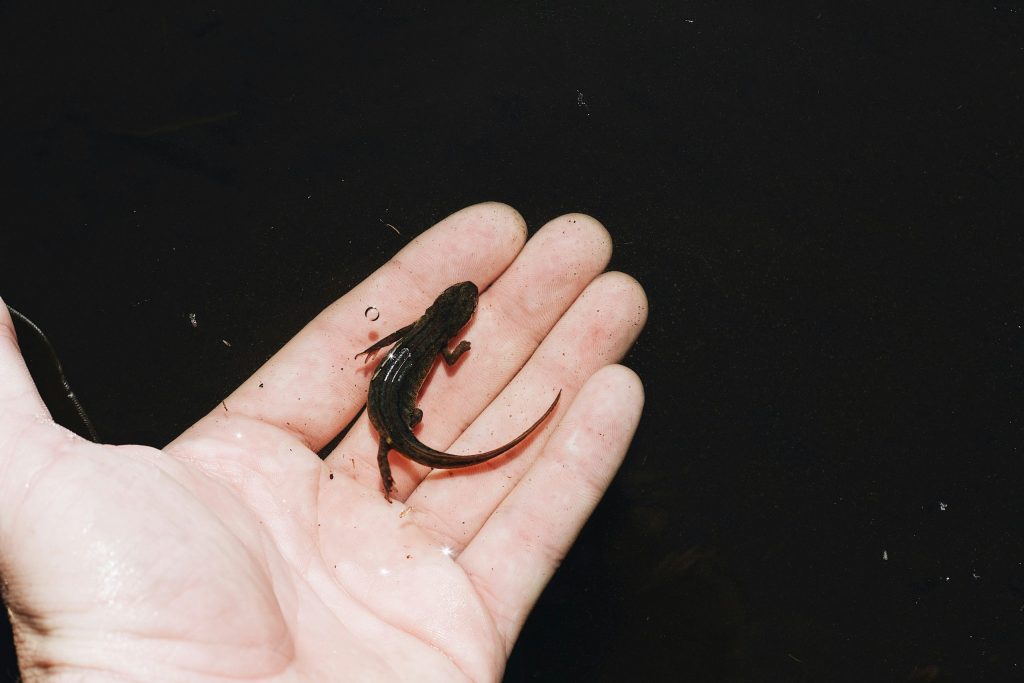Recently, I’ve adopted a new mantra. If you’re surprised to learn that it comes from the mouth of my 5-year-old nephew—a mouth often smeared with ketchup and/or chocolate ice cream—well, clearly, you haven’t met Dean. Granted, the kid is a grubby little hellion who refers to his dear uncle as Mr. Buttcheek Man, but he’s also quite introspective and bright. And more to the point, he’s very, very, very into catching.
That’s Dean’s term for the meaning of life—i.e., searching the creek behind his house in rural Vermont for “sea creatures”: frogs, toads, salamanders, newts, crayfish, minnows, and maybe, he hopes, eventually, a giant squid or manatee. Since the start of the summer, he’s been obsessed, scouring the local micro-wilds for shy, slimy animals that most six-foot-tall grown-ups fail to notice, let alone appreciate. He wades through eddies. Shuffles stones. Pokes into mucky nooks and peeks into murky crannies. Double-checks those super-intriguing stones. It’s his raison d’être, his religion, his answer to the riddle of existence—finding and catching, with net, bucket, and bare hands, the hidden-in-plain-sight wonders of the everyday backyard.
A couple of weeks ago, apropos of nothing, or perhaps apropos of everything, Dean said: “You catch them. You study them. You release them. You think about them.” I nearly fell out of my chair, stunned by the layered wisdom of this impromptu statement. A practice of awareness and engagement! A rich and enriching way to be! Indeed, those four words, like any genuine mantra, bear repeating.
Catch. As adults, what are our hidden-in-plain-sight wonders, our “sea creatures”? Simply put, they are moments: clouds at dusk blushing pink; an adolescent girl limping in the cereal aisle, grimacing as she reaches for the Frosted Flakes; two dogs thumping a syncopated beat against the hardwood floor with their tails; dewdrops suspended by an invisible spider web; an elderly fellow sunning his legs on a park bench, surrounded by pigeons, everybody cooing; the lilac-perfumed breeze. Recognizing that such easily overlooked details deserve our regard in the first place is paramount. Too frequently, we are busy and scattered, oblivious. To catch is to be turned on, tuned in. Alert to our environs. Poised to pull images and sensations from the eternally flowing stream—er, creek—of time.
Study. It’s one thing to pause and acknowledge the beauty of the blushing cloud, the pathos of the limping girl, then resume your frantic, self-absorbed work three seconds later, nose-to-the-grindstone style. It’s entirely different to full-on accept the invitation of that which has been caught—to hop into the net or plunge into the bucket, as it were, and actively observe. What happens when we rotate the moment in consciousness? When we examine it from various angles? Be thorough. Be tender. Be like a mesmerized child: unblinking, uncertain, unconcerned with the clock, totally immersed and totally stoked. This, right here, right now, is the truly pressing work.
Release. Moments are by definition fleeting, even if we stretch them with our intention and focus, even if they magically last ten minutes or an hour. We’re talking about a practice of awareness and engagement, not desperate clinging attachment, eh? Catching isn’t keeping. Studying isn’t owning. Ephemerality, transience, flux, change—it’s difficult, but we need to respond to the relentless dynamism of the everyday backyard by choosing to let go. Says Dean: “They suffer if you don’t release them.” The sea creatures? The wonders? Says his uncle: “Yeah, and so do we.”
Be like a mesmerized child: unblinking, uncertain, unconcerned with the clock, totally immersed
Think. If the catch was good, the study deep, the release joyous and complete, when we move down the creek, sloshing toward the next sudden/humdrum/awesome/common/shocking encounter, a memory will come along for the ride. The moment we “lost” is inside us, an element interacting with other elements, puzzling together to create our picture of the world and our understanding of where we fit in the mix. Questions arise: How do these pieces connect and converse? What do they mean? And dang, isn’t it special that, above and beyond meaning anything in particular, they seem to shimmer and twitch with a kind of basic indestructible significance? Contemplating sheer thusness and experience for experience’s sake, we trip on a log, hit a shallow green pool with a splash, and glance left to see—holy crap, is that a manatee?
Thereby the mantra loops, as mantras must, and begins anew.
Earlier, I described the tools of Dean’s trade as net, bucket, and bare hands, but that’s an insufficient list. What he fundamentally relies on—what we all rely on, whether we know it or not—is an open mind and heart. Trace the etymology of “enthusiasm” to its source and you arrive at the ancient Greek enthousiazein: “be inspired or possessed by a god.” My nephew’s relationship with the local micro-wilds suggests that the earth draws us into awareness and engagement if only we make ourselves available. That the core of the practice is heading to the creek just because. That curiosity is our human birthright. “Mr. Buttcheek Man, quick, quick, look at my catch!”
After roughing out a draft of this essay, I mentioned it in an email to my sister, Molly, the grubby little hellion’s mother. “My feelings exactly,” she replied. “It’s the family mantra, no doubt. We’ve recently added a fifth word: Dream. Every night, Dean snuggles into bed with his two shark stuffies and assorted other sea creatures, gives each a hug, and voyages off to the Atlantic or the Pacific or wherever for an adventure. And every morning, rain or shine, he wakes up and immediately asks: When can we go catching again?”
Of course, the answer is always the same, yet another mantra to repeat, to chant, to sing: Today, today, today, today, today.
Thank you for subscribing to Tricycle! As a nonprofit, we depend on readers like you to keep Buddhist teachings and practices widely available.
